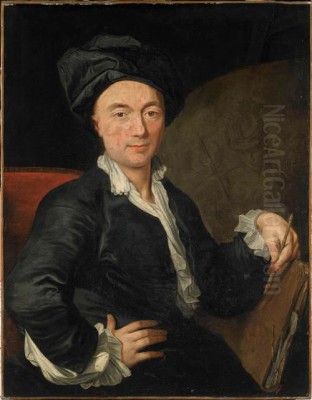
Jean-Baptiste Pater stands as a significant figure in the glittering era of French Rococo painting. Born in Valenciennes on December 29, 1695, and passing away in Paris on July 25, 1736, Pater’s relatively short life coincided with a period of profound artistic and cultural transformation in France. He is best known as the most dedicated follower, and indeed the only documented pupil, of Antoine Watteau, the very originator of the fête galante genre. Pater skillfully absorbed his master's style, yet developed his own distinct artistic personality, contributing significantly to the visual language of Rococo leisure, elegance, and charm.
Formative Years in Valenciennes
Pater's artistic journey began in his hometown of Valenciennes, a city in northern France that had relatively recently become part of the kingdom. His father, Antoine Pater, was a sculptor, providing Jean-Baptiste with his initial exposure to the world of art. Following this early guidance, the young Pater formally apprenticed under a local painter named Jean-Baptiste Guide, beginning his training around 1706. This foundational period grounded him in the technical aspects of painting prevalent in the region.
However, the most pivotal moment in his early career was his encounter with Antoine Watteau. Also hailing from Valenciennes, Watteau had already achieved considerable fame in Paris. Around 1713, Pater briefly entered Watteau's studio as a student. This initial period of study was reportedly cut short due to a clash of temperaments between the established master and the aspiring pupil. Despite this early friction, the encounter left an indelible mark on Pater's artistic vision.
The Shadow and Light of Watteau
The relationship between Pater and Watteau remained complex but ultimately defining for Pater's career. Though their initial tutelage was brief and ended abruptly, Watteau's influence was undeniable. Fate brought them together again shortly before Watteau's untimely death from tuberculosis in 1721. Sensing his end was near, Watteau summoned Pater back to his side. During this poignant final month, Watteau imparted further instruction and guidance to his former pupil.
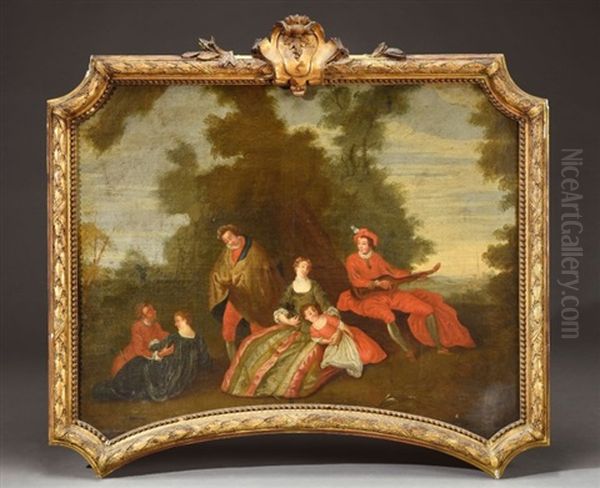
This final period of intense learning cemented Pater's dedication to Watteau's style. It is said that Pater even helped complete some of Watteau's unfinished works after his master's passing. More importantly, he fully embraced the fête galante – idyllic scenes of elegant figures enjoying themselves in park-like settings – the genre Watteau had pioneered. Pater became the most prominent artist to carry forward this specific thematic and stylistic legacy, making him Watteau's true artistic heir.
Relocation and Parisian Success
Like many ambitious artists from the provinces, Pater sought recognition in the bustling artistic center of Paris. He faced difficulties establishing himself independently in Valenciennes, possibly due to local guild regulations or simply the desire for a larger stage. Around 1718, he made the decisive move to the capital, where he would spend the remainder of his life.
In Paris, Pater diligently honed his craft, focusing on the popular fête galante themes inherited from Watteau. His skill and dedication gradually earned him recognition. A significant milestone occurred on October 31, 1728, when he was formally accepted into the prestigious Académie Royale de Peinture et de Sculpture (Royal Academy of Painting and Sculpture). His reception piece, La Rejouissance des Soldats (The Soldiers' Merrymaking), showcased his talent within a variation of the fête galante, applying its elegance to a military theme. Membership in the Academy solidified his status as a respected professional artist in Paris.
The Essence of Pater's Rococo
Pater's art is quintessentially Rococo, characterized by lightness, grace, and a focus on the pleasures of aristocratic life. His primary subject matter remained the fête galante, depicting elegantly dressed men and women conversing, flirting, playing music, or simply relaxing in lush, idealized landscapes. These scenes evoke an atmosphere of carefree leisure and refined sociability, hallmarks of the Régence and early reign of Louis XV.
Stylistically, Pater adopted Watteau's delicate brushwork and emphasis on color. However, he developed his own nuances. His color palette often featured soft pastels but could incorporate more vibrant hues, with sources noting a particular fondness for blues and certain acid greens that added a distinct shimmer to his canvases. His figures, while elegant, sometimes possess a slightly more robust or less ethereal quality than Watteau's. While perhaps lacking the profound poetic melancholy occasionally found in Watteau, Pater's works excel in their decorative charm, lively compositions, and skillful rendering of textures, particularly silks and satins.
Themes of Leisure and Elegance
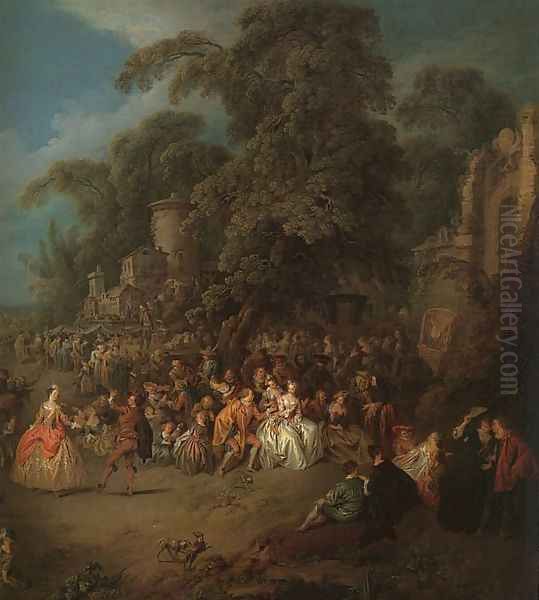
The fête galante was Pater's métier. Within this genre, he explored various facets of aristocratic entertainment and courtship. Garden parties, outdoor concerts (concerts champêtres), theatrical performances (or figures dressed in theatrical costume), and scenes of gentle flirtation dominate his oeuvre. These paintings were not meant as realistic portrayals but rather as idealized visions of a refined social world, reflecting the tastes and aspirations of his clientele.
He shared this thematic focus with other prominent Rococo artists. Nicolas Lancret, another follower of Watteau (though not a direct pupil in the same way as Pater), also specialized in fêtes galantes and scenes of elegant society. While comparisons are often drawn, Pater maintained his own stylistic identity, often seen as slightly more fluid or painterly than Lancret's sometimes crisper definition. Both artists, however, played crucial roles in popularizing these charming depictions of contemporary aristocratic life.
Exploring Military Life
While best known for garden parties, Pater also distinguished himself with his treatment of military themes, as seen in his Academy reception piece, La Rejouissance des Soldats. Unlike traditional heroic battle paintings, Pater focused on the more mundane or leisurely aspects of soldiers' lives: troops halting on the march, resting in encampments, or engaging in moments of celebration and relaxation.
These works retain the elegance and refined technique of his fêtes galantes, applying a Rococo sensibility to a typically more austere subject. He depicted soldiers not necessarily as heroes in combat, but as figures within a picturesque scene, often interacting with female camp followers, adding a touch of the galante even to the military setting. This approach offered a fresh perspective and contributed a unique sub-genre to his output. Other artists like Carle Van Loo also depicted military subjects during this period, but often with a different emphasis or scale. Pater's contribution was notable for its consistent charm and intimacy.
Exoticism and Royal Commissions
Like many artists of his time, Pater occasionally incorporated elements of exoticism into his work, catering to the fashionable taste for Turquerie (Turkish-inspired themes) and Chinoiserie (Chinese-inspired themes). His painting Le Sultan en harem (Sultan in his Harem) is a clear example of Turquerie, depicting an imagined scene of life in an Ottoman court, rendered with Rococo grace and sensuality.
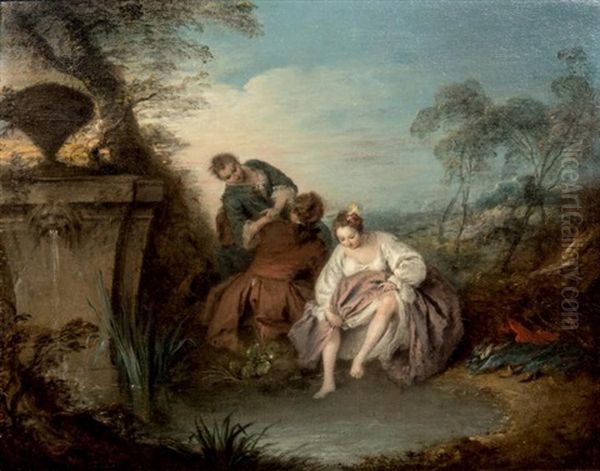
His engagement with Chinoiserie is evidenced by a significant commission later in his career from King Louis XV himself. Pater was asked to create paintings depicting Chinese hunting scenes (Halte de Chasse). This royal patronage underscores his established reputation. The taste for exotic themes was widespread in the Rococo period, famously embraced by artists like François Boucher, whose decorative panels often featured playful interpretations of Eastern motifs. Pater's contributions reflect his participation in these broader artistic trends.
Masterworks in Focus: Concert Champêtre
Among Pater's most representative works is Concert Champêtre (Pastoral Concert or Country Concert). Several versions of this theme exist, typically depicting a group of finely dressed individuals gathered in a park-like setting, engaged in making music or listening attentively. The compositions are usually relaxed and informal, yet imbued with an air of sophistication.
These paintings showcase Pater's skill in rendering figures, costumes, and landscapes. The settings are often idealized, with soft, feathery trees and gentle light creating a dreamlike atmosphere. The interplay between the figures, their elegant postures, and the surrounding nature captures the essence of the fête galante – a harmonious blend of human sociability and idealized landscape, all rendered with Pater's characteristic delicate touch and appealing color palette.
Masterworks in Focus: The Fair at Bezons
Another significant work is The Fair at Bezons (La Foire de Bezons). This painting presents a more bustling scene than the typical intimate garden party. It depicts a lively village fair, populated by a diverse crowd including country folk, townspeople, performers, and aristocrats mingling together. The setting is a broad, open plain under a luminous sky.
This work is often seen as Pater's interpretation and modernization of themes explored earlier by Watteau, such as scenes involving Italian commedia dell'arte characters or peasant gatherings. Pater's version is filled with anecdotal details and captures the energy of a popular festival. It demonstrates his ability to handle larger, more complex compositions while maintaining the Rococo lightness and charm. The painting offers a vibrant snapshot of 18th-century social life, encompassing a broader spectrum than his more exclusive aristocratic gatherings.
Other Notable Works
Pater's oeuvre includes numerous other charming works that exemplify his style and thematic range. Titles like L'essai du bain (The Bath), often depicting intimate scenes of women bathing or at their toilette, showcase his ability to render the female form with Rococo sensuality and grace. The Guitarist highlights the common theme of music within his work, while The Fortune Teller introduces an element of playful superstition and social interaction.

Paintings such as Scène galante dans un parc (Gallant Scene in a Park) and La conversation intéressante (The Interesting Conversation) return to his core theme of refined outdoor gatherings. Works like Actors Arriving at Mans and Brawl in a Public House (reportedly held at Potsdam) suggest a wider narrative scope, perhaps influenced by Dutch and Flemish genre painting but filtered through a Rococo lens. Collectively, these works demonstrate Pater's versatility within the prevailing tastes of his era.
A Network of Artists
Jean-Baptiste Pater operated within a rich artistic milieu. His primary influence, Antoine Watteau, stands paramount. He is often discussed alongside Nicolas Lancret as the principal inheritors of Watteau's fête galante. Other major figures of French Rococo painting were his contemporaries, including François Lemoyne, known for his large-scale historical and mythological works with a lightened palette; the immensely prolific and influential François Boucher, master of mythological scenes, pastorals, and decorative schemes; and later, Jean-Honoré Fragonard, who pushed Rococo exuberance and sensuality to its zenith.
Pater would also have been aware of portraitists like Jean-Marc Nattier, who depicted court ladies in mythological guise, and the great pastel artists Maurice Quentin de La Tour and the Venetian Rosalba Carriera (who visited Paris and was highly influential). History painters like Charles-Joseph Natoire and Carle Van Loo were prominent members of the Academy alongside Pater. Even artists specializing in different genres, such as the still-life painter Jean-Baptiste-Siméon Chardin, contributed to the overall artistic climate of the time. Pater's work, while focused, existed within this dynamic network of stylistic exchange and thematic exploration.
Esteemed Patronage
Pater's charming and fashionable paintings found favor with prominent collectors and patrons. One of his most significant admirers was Frederick the Great of Prussia. Before and after ascending the throne, Frederick amassed a substantial collection of French Rococo art, and Pater's works featured prominently. Numerous paintings by Pater adorned the walls of Frederick's palaces, particularly Sanssouci and the Neues Palais in Potsdam, testifying to the artist's appeal beyond French borders.
His commission from Louis XV for the Chinese Hunting Scenes further demonstrates his recognition at the highest levels of French society. The demand for his works among the aristocracy and wealthy bourgeoisie provided him with a steady livelihood, allowing him to dedicate himself fully to his art. This patronage was crucial for sustaining his career and disseminating his style.
A Life Dedicated to Art
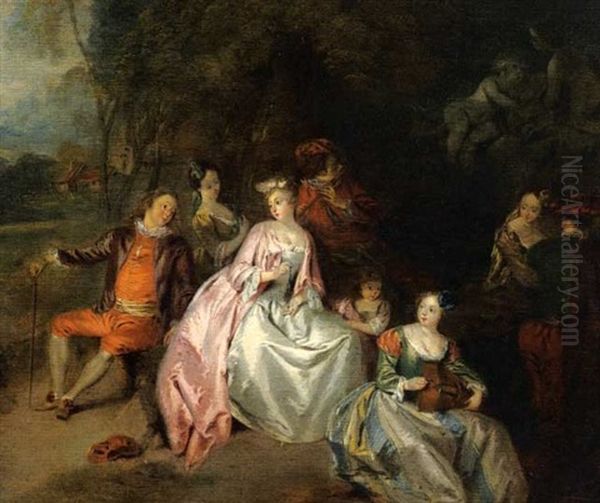
Contemporary accounts suggest Pater was exceptionally hardworking and dedicated to his craft. Perhaps mindful of his relatively late start in achieving major recognition, or simply driven by artistic passion, he reportedly worked relentlessly. Sources describe him as living a rather simple and solitary life, despite his professional success. He never married and seems to have focused his energies almost entirely on painting.
His intense work ethic may have contributed to his early death. He passed away in Paris in 1736 at the age of just 40. Some biographers have speculated that his demise was hastened by consumption (tuberculosis, the same disease that claimed Watteau) or possibly exhaustion from overwork. His death cut short a career that was still actively producing works sought after by collectors across Europe.
Enduring Legacy: Collections
Today, Jean-Baptiste Pater's paintings are held in major museums and collections around the world, confirming his lasting importance in the history of French art. The Musée du Louvre in Paris holds key examples. His work L'essai du bain can be found in the Musée national des châteaux de Versailles et de Trianon. The Wallace Collection in London possesses fine examples, including La conversation intéressante.
In the United States, the Metropolitan Museum of Art in New York holds works like Troops on the March (likely the intended title for Troops on Paté mentioned in sources), while the Cleveland Museum of Art houses The Guitarist. His paintings related to Frederick the Great's collection remain associated with the palaces in Potsdam, Germany. Works also appear in the National Gallery of Art in Washington D.C., the Getty Center in Los Angeles, and numerous other public and private collections, demonstrating his widespread and enduring appeal.
Enduring Legacy: Exhibitions
Pater's work continues to be studied and appreciated, as evidenced by its inclusion in significant exhibitions focusing on Rococo art. While perhaps less frequently the subject of large monographic shows compared to Watteau or Boucher, his paintings are regularly featured in thematic exhibitions exploring the fête galante, 18th-century French painting, or the collections of patrons like Frederick the Great.
Sources mention exhibitions involving his work at institutions like the Mariani Foundation (2006) and the Metropolitan Museum of Art (2009). A 2020 exhibition in Marseille titled "The Law of the Senses" reportedly included works by Pater and his contemporaries, highlighting the sensory appeal and thematic concerns of Rococo art. These instances demonstrate the ongoing scholarly and public interest in his contribution to the period.
Conclusion: Capturing the Rococo Spirit
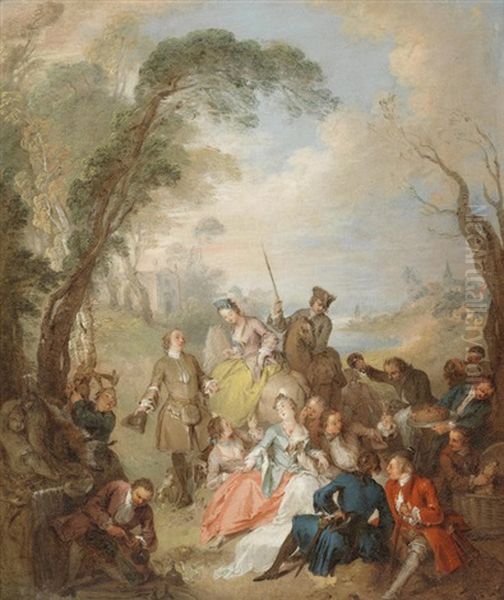
Jean-Baptiste Pater occupies a crucial position in the story of French Rococo art. As Antoine Watteau's most direct artistic descendant, he skillfully perpetuated and popularized the fête galante, making it one of the defining genres of the era. While deeply indebted to his master, Pater developed his own recognizable style, characterized by charming compositions, delicate brushwork, and an appealing, often shimmering color palette.
His paintings masterfully capture the spirit of aristocratic leisure, elegance, and refined pleasure that marked the Régence and the reign of Louis XV. From idyllic garden parties and musical interludes to unique interpretations of military life and fashionable exotic themes, Pater's work offers a delightful window into the visual culture of his time. Though his life was short, his dedication to his art resulted in a significant body of work that continues to enchant viewers and secure his place as a master of the French Rococo.